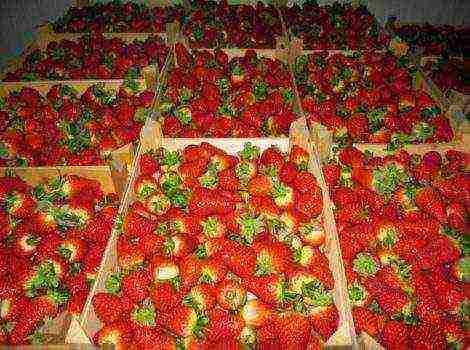Content
- 1 Description
- 2 Video "Everything about black radish - from seed to harvest"
- 3 Growing
- 4 Radish varieties
- 5 Beneficial features
- 6 Video "Useful properties of black radish"
- 7 Types of radish
- 8 Oil radish
- 9 Margelan or Chinese radish
- 10 Black radish
- 11 Green radish
- 12 Daikon radish is a large white radish
- 13 Wild radish
- 14 Sweet radish
- 15 Preparing the soil for planting winter radish
- 16 We plant in the grooves
- 17 Cleaning and storage
- 18 Winter radish varieties
Black radish is considered the most useful of all varieties of this vegetable crop. Our ancestors also grew it not only as a food product, but also as a medicinal plant. Although black roots are inferior in taste to other types of radish, they surpass many natural remedies in the composition of nutrients and healing properties. Growing black radish is not a difficult and even exciting process: it can grow in any conditions, and it does not need complicated care. In addition, black winter radish has the longest shelf life, which allows it to be consumed from autumn to spring.
Description
Black radish is a two-year vegetable crop of the Cabbage family. In the first year, the plant forms a root crop and a rosette of basal leaves, and in the second, it expels a high (up to 60 cm) erect stem with an inflorescence, from which a pod with seeds is then formed. The leaves of the radish are lyre-shaped, dissected, green or grayish in color, slightly rough. The flowers are small, purple or white, collected in racemose inflorescences. The fruits of the plant are long pods containing up to 10 g of black globular seeds.
Only root vegetables are used for food, the shape of which is round, oblong or conical. The mass of root vegetables can vary from 180 to 500 g, the diameter is 8-10 cm for round vegetables and 4-5 for long ones.
The skin is thin, but very dense, black or dark gray in color. Under the peel there is a white juicy pulp containing many useful substances, vitamins and biologically active compounds. Taste of radish is similar to radish, but due to the high content of essential oils, it has a pronounced burning aftertaste.
The birthplace of the radish is Asia. In the CIS countries, only its cultural species grow. Propagated by seeds, which are sown in early spring for summer harvest, and in the second half of summer for winter harvest, however, most varieties of black radish are winter, therefore harvesting is carried out in late autumn. Vegetables are stored very well and for a long time, which allows them to be consumed from autumn to late spring.
Video "Everything about black radish - from seed to harvest"
From the video you will learn how to properly grow a radish.
Growing
Agrotechnics and caring for black radish are not particularly difficult. The culture is frost-resistant, so its cultivation is possible in any, even the coldest climate. For the summer harvest, the radish is sown in late March - early April, but since most varieties are winter varieties, the sowing of black radish is carried out mainly in mid-July in order to get a harvest by autumn.
Even a novice vegetable grower knows how to grow black radish. First, you need to prepare a site for planting a crop - for summer sowing, the garden bed is prepared in the spring: it is dug up to 25-30 cm, and fertilized (humus, compost, superphosphate, potassium salt) if the soil is not fertile enough. If sowing is carried out in the spring, then the preparation of the beds is carried out in the fall. Root crops grow well in loose loamy or sandy loam soil with neutral acidity, so it is desirable to achieve such characteristics in the allotted area.
When the bed is ready, holes or rows are made in it, in which seeds are planted in nests (3-4 pieces each).For radish, planting according to the 20x40 scheme is preferable, where 20 cm is the distance between plants, and 40 cm is the distance between rows, but varieties with long roots can be planted denser. Seeds are planted in moist soil to a depth of 2-3 cm, covered with earth, slightly compacted. To make it easier to care for plants, many growers mulch the garden, but this is not necessary. The sprouts appear quite quickly - on the 5-7th day, and if under the film, moreover, the seeds were germinated, then it is possible after 3 days.
Further care of the radish consists in regular loosening and weeding (if there is no mulch), watering as needed, 2-3 dressings during the growing season. As a top dressing, you can use special complex soluble mixtures "Aelita - vegetable", "Kemira". During the ripening period of root crops, it is necessary to add potassium - the taste of vegetables depends on this element. The crop is harvested as the root crops grow to the desired size. The ripening period of black radish depends on varietal characteristics and can be 65-100 days.
Radish varieties
A simple consumer may think that black radish is a separate variety, but this concept is generalized. Radish with black roots, like other types of crops, has many varieties and hybrids, the most common of which are:
- Winter black. The most popular and long-cultivated winter variety. The roots of this radish are the richest in mineral salts, vitamins and essential oils (as evidenced by their pronounced bitter taste), and in terms of useful properties they are comparable to garlic. Medium late (75-100 days) ripening variety. The root crop is round, large (240-500 g), the surface is smooth, black in color. The flesh is white, very dense, with a spicy taste. The radish is perfectly stored, intended for winter use.
- Murzilka. Late (90-100 days) variety for winter use. Root crops are round, rather large (diameter 8-10 cm, weight 210-300 g). The peel is grayish-black, rough, dense. The pulp is white, juicy, medium sharp. In cool conditions, root crops are perfectly preserved until spring.
- Draft. Late-ripening (100-110 days) winter variety of domestic selection. Root crops are large (up to 340 g), even, rounded. The rind is black, rough. The pulp is dense, very juicy, delicate, sweetish-spicy taste. The radish of this variety has an excellent presentation and is stored for a long time.
- Night. A mid-season (70-85 days) domestic variety, included in the State Register of the Russian Federation. Designed for private and industrial cultivation. Root crops of an attractive appearance: round, leveled, intense black color. Average weight 230-350 g, white pulp, soft, slightly spicy taste, very juicy, crunchy. The yield of the variety is 3.5-4 kg / 1 sq. m. Stored for a long time, well transported.
- Black woman. Another winter variety included in the State Register as a crop intended for cultivation in subsidiary plots. Ripening period 75-90 days. The leaves are grayish-green, the rosette is compact. Root crops are large (up to 300 g), round, slightly elongated, black in color. The pulp is creamy, dense, with a mild taste. Suitable for summer cultivation and autumn harvest.
- Black dragon. Medium early (50-65 days), black radish with dietary properties and mild, mild taste. Root crops are long (12-17 cm), cylindrical, pointed towards the bottom, of average weight (150-210 g). The peel is smooth, black, the flesh is white, firm, but very juicy. Stored for a long time without loss of taste, suitable for winter consumption.
- Healer. Mid-season variety (75-85 days) of domestic selection. Root crops are round, elliptical, large (up to 280 g). The peel is black in color, the flesh is white, crispy, medium sharp. The yield is high - up to 4.5 kg / 1 sq. m. Stores well during the winter.
- The Queen of Spades. A mid-season variety (62-70 days), intended for winter consumption, is included in the State Register of the Russian Federation.The root crop is cylindrical, pointed, large in size (350-500 g). The rind is black, dense, the flesh is light, the taste is slightly spicy. The variety is resistant to the formation of arrows, minimal maintenance is required. The yield is high - up to 6 kg / 1 sq. m.
Beneficial features
The healing properties of black radish are recognized not only by folk, but also by traditional medicine.
Of all natural products, it has the most powerful therapeutic effect, and, in fact, is a natural antibiotic due to the presence of glycosides in roots - substances with antimicrobial action.
The inclusion of radish in the daily diet helps to significantly improve the general condition, strengthen the immune system, heart and nervous systems, and look younger.
Since ancient times, black radish has been used as a folk remedy for the treatment of:
- colds and viral diseases (sore throat, runny nose, cough, including whooping cough) - radish juice with honey effectively relieves coughing attacks, and gruel from grated pulp can be applied instead of mustard plasters for pneumonia;
- to restore and cleanse the liver - fresh juice has an excellent choleretic effect;
- pain and swelling in the joints - radish juice with honey, vodka and salt, when rubbed in, quickly relieves pain, the mixture can also be consumed internally;
- to improve digestion - juice and salads from fresh root vegetables eliminate congestion in the stomach and intestines, kill bacteria, restore flora, remove toxins;
- cleansing blood vessels from cholesterol
- strengthening hair, nails, enhancing their growth - the juice and gruel of root vegetables are rubbed into the skin;
- to stop the growth of malignant tumors.
The most healing remedy for most diseases is radish juice mixed with honey. Drinking a glass of the drink every day, you can get rid of vitamin deficiency, regulate the water-salt balance and restore metabolic processes. It is useful to include root vegetables in the menu in spring, when the body especially needs vitamins and minerals. Remember that in terms of the content of esters and phytoncides, which determine the bitter taste of a vegetable, radish is comparable to garlic and horseradish, so include a healthy product in your diet as often as possible.
Video "Useful properties of black radish"
From the video you will learn what medicinal and useful properties a radish has.
Radish varieties
Rate this post
Radish is grown all over the world. For many centuries, peoples have appreciated its characteristic taste, nutritional properties and its healing qualities. The culture is quite unpretentious. Breeders from different countries are constantly working to create new species and varieties.
Types of radish
Different sources give different information about the number of radish species. Part of them:

White radish - Raphanus candidus Worosch.
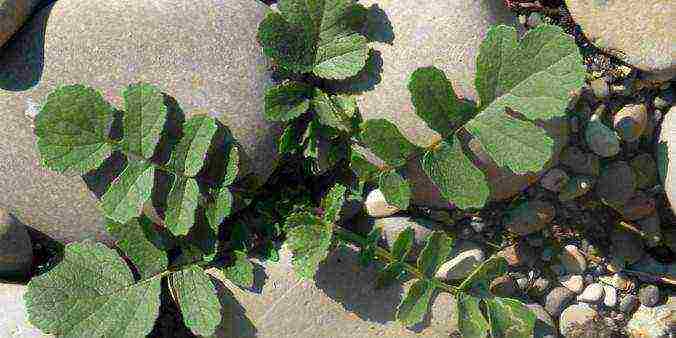
Seaside radish - Raphanus maritimus Sm.
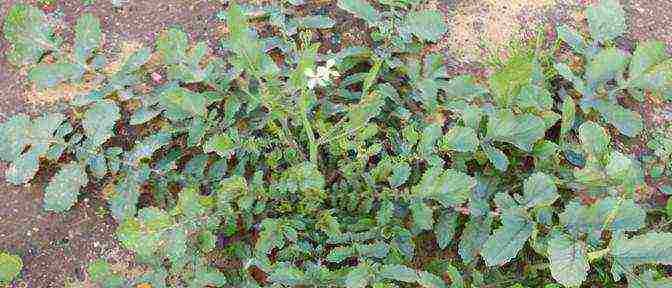
Wild radish (she - Field radish) - Raphanus raphanistrum L.
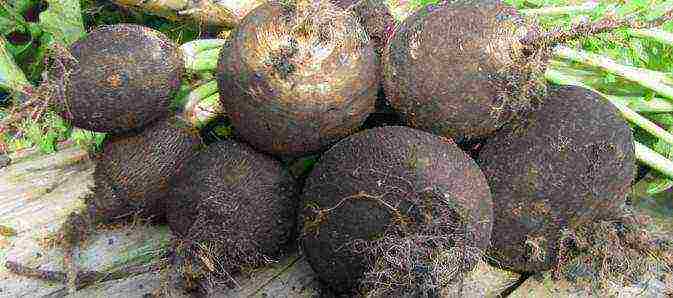
Sowing radish, Garden radish, Radish - Raphanus sativus L.
Some experts classify them as groups of varieties, others as varieties. Among the groups of plants of this species, the most famous are radish, margelan radish (“loba” or “lobo”), black radish, daikon.
Oil radish
The oil radish is an annual plant in the Cruciferous family. It can reach a height of 2m. Cold-resistant, shade-tolerant and moisture-loving. Able to give a large harvest. The flowers are white - purple in color. From the moment of emergence to the moment of flowering, about 40 days pass. The best time to sow seeds is June-July. Optimum depth for sowing seeds: 2-3 cm.
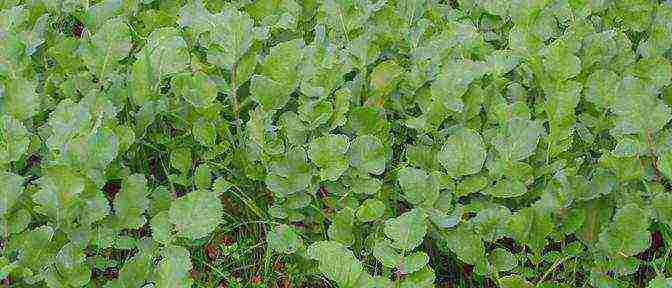
The plant adapts well to a wide variety of conditions. It is grown on any soil. Drought tolerant. For this reason, the process of growing it is not very difficult. In addition, the plant does not require a large amount of fertilizer. An overgrown crop can be used as compost. Due to the rapid growth, the radish is able to clog many weeds, actively suppresses nematodes. In vineyards, it can stimulate the growth and development of the vine.
Margelan or Chinese radish
Margelan radish, which is also often called Chinese radish, as well as "Loba" or "Lobo". Its roots are juicy and dense. They can be round or elongated. They occupy a middle place between daikon and between European varieties. "Loba" is stored worse than European varieties and its pulp is not so weakly pungent. All its varieties and hybrids are salads. Root crops can be different in color and color. Pink-red, light green, lilac-purple, dark green. But the top of the heads in any case has an intense green color. The roots are neither bitter nor pungent. Elderly people and people suffering from liver and heart diseases can eat them. "Loba" stimulates appetite, activates intestinal peristalsis. It is advised to use it for kidney stones or stones in the bladder, gout, scurvy, cough. "Loba" is used as an antiseptic - for the treatment of purulent ulcers and wounds. And as a local sedative - for neuritis, radiculitis and muscle pain.
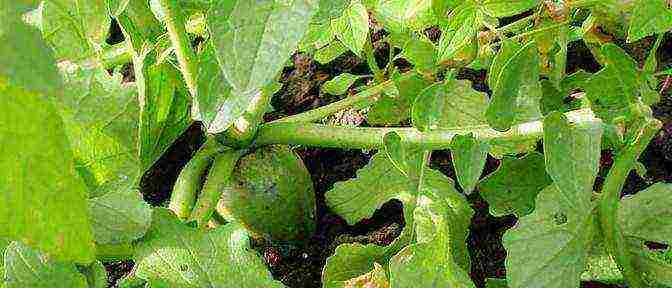
Root vegetables contain many beneficial and nutritious substances. Mineral salts, carotene, vitamins, calcium, magnesium. Essential oils, fiber, proteins, enzymes.
"Loba" removes cholesterol, toxins, salts from the body.
It is best to plant it after legumes, potatoes, onions and tomatoes. The seeds must be full. It is better to sow them in the second half of summer. In this case, the risk of the appearance of early peduncles is reduced. The plant is demanding on moisture. Regular watering is especially important during the formation and formation of root crops. In dry weather, regular watering is required.
The highest yield can be obtained on fertile soils. The plant responds well to organic fertilizers. Planting care is to prevent thickening. In addition, you should protect them from pests. The beds must be kept clean.
The best varieties: Zareva, Fang of an elephant, Margelanskaya, Oktyabrskaya-1. Pink ring, Oktyabrskaya-2, Severyanka 9809457, Troyandova.
The Red Heart variety can be distinguished separately. It has a light green surface. And its inside is very similar to a watermelon. The pulp is soft, juicy, practically without bitterness. You can store the harvest all winter.
Black radish
Black radish loses compared to other varieties in its taste, but at the same time its medicinal properties are highly valued. She uses roots and seeds. A biennial plant forms a root crop in the first year, seeds in the second. The root crop usually grows to a weight of 2-3 kg. The plant blooms in April - May. Root crops ripen a month after flowering. They treat arthritis, dispersions, coughs.
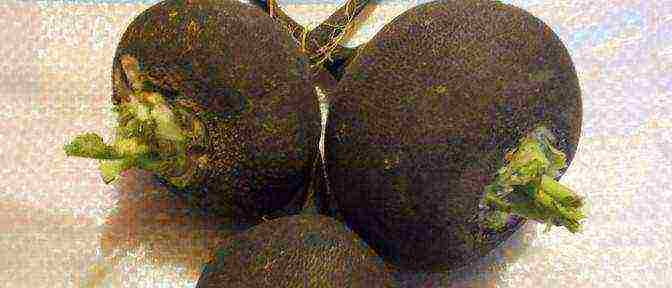
It is rich in enzymes, carotene, vitamin C, choline, magnesium, essential oils, proteins, fats. She was popular with the ancient Egyptians. The pyramid builders generously added it to their diet. Other varieties are also used to combat many diseases, but black is considered the most effective.
Green radish
Green radish is not as valued for its medicinal properties as black radish, but it is also quite useful. Its taste is more delicate and pleasant. She comes from Uzbekistan.
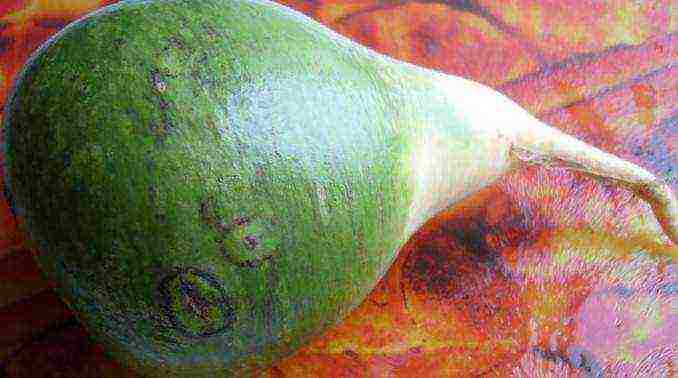
It is rich in amino acids, vitamins, carotene, phytoncides, sodium, phosphorus, potassium. Sulfur, essential oils, calcium. It can support a weakened immune system and improve well-being. It helps with coughs, bronchitis, dysbiosis, colds, whooping cough, and improves bowel function. It removes cholesterol from the body, destroys microbes, and has bactericidal properties. Improves appetite. Rub the body with grated gruel for muscle inflammation, neuritis, gout and rheumatism.
Daikon radish is a large white radish
The daikon plant is gaining more and more popularity. In Russia it is called "white radish". Sometimes "white radish" - it is a "relative" of both of them. The root vegetables of the daikon radish can be up to 60 cm long. Their diameter is 5-10 cm.It is appreciated for its unpretentiousness, excellent taste and healing properties. Only 100 g of the root contains 40% of the daily requirement of vitamin C. Daikon is also rich in other vitamins, sulfur, beta - carotene, folic acid, magnesium and copper. Potassium, iron, selenium, iodine, fiber. It strengthens the body remarkably. Improves digestion, dissolves kidney and gallstones. Daikon phytoncides fight germs and also slow down the growth of dangerous bacteria. Prolonged use of raw root vegetables improves heart function and cleanses blood vessels, relieves the body of cholesterol.
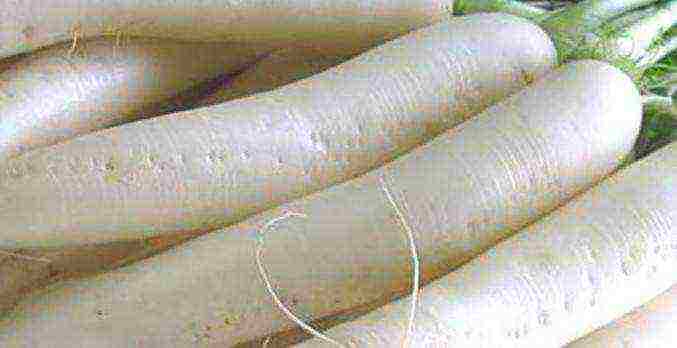
A distinctive feature of daikon is that when it is grown in dirty soil, it accumulates little harmful substances. Three times less than other vegetables - for example, than carrots or beets. It is believed that eating it raw will neutralize the radioactive effect.
If you cut the daikon into thin slices and sprinkle with sugar, then after a while it will give a delicious juice. For lactating women, this juice will help improve lactation. If you mix warm juice and honey, you get an excellent remedy for bronchitis. Root vegetables are useful, but it is better to consult a doctor before using it.
They eat not only the root, but also seeds and greens. The seeds are germinated, green leaves are added to salads. The root is boiled, baked, pickled, fried, added to soups and cabbage soup. Prepared as an independent dish.
It is added to rice dishes, sushi and sandwiches. The pickled fruits are called takuan. According to legend, the monk Soho Takuan came up with this way to save root crops for the winter.
It is best to consume the crop immediately after harvest. Nutrients are quickly lost. But a daikon can lie in a plastic bag in the refrigerator for several days.
Wild radish
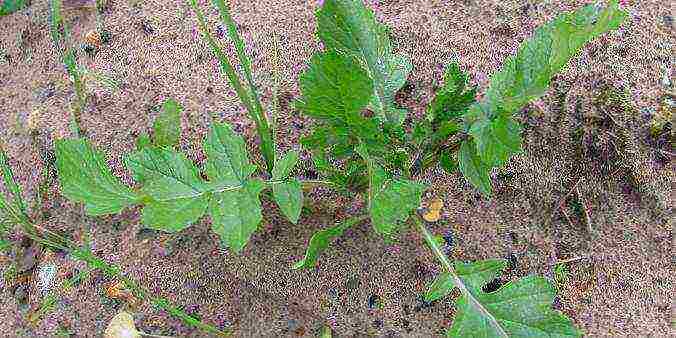
Wild radish is common in all Central Russian regions. It is an annual herb. It is considered a good honey plant. Weedy. Occurs in fields, wastelands, in vegetable gardens. Its branchy stem, pubescent with simple hairs, reaches a height of 15 to 70 cm. The root of the plant is thin. The leaves are lyre-pinnately dissected, covered with stiff hairs. Petals are yellow, rarely white. Flowering occurs in May - August. The plant bears fruit in June-September. The fruits are pods with a long nose. When they are ripe, the pods break into separate segments.
Sweet radish
The vegetable is characterized by its bitterness and pungency. But, nevertheless, you can find sweet root vegetables. Most often they are bred and grown in China and Japan. For example, the Sakurajima variety. It allows you to collect huge sweet roots up to 16 kg. He is a masterpiece of world selection. Daikon and forehead are considered sweet radish. They contain almost no bitter oil.
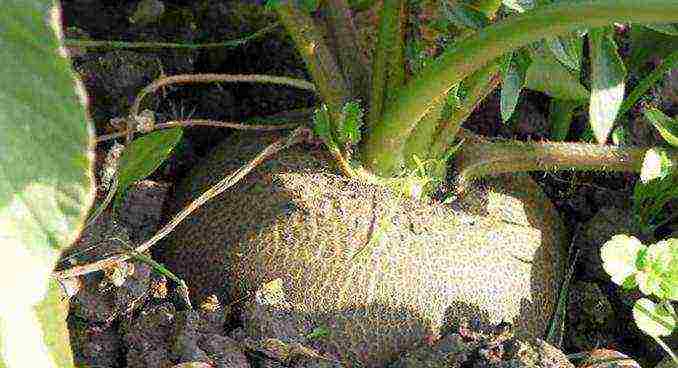
Plants do not adapt well to new places. Therefore, seeds harvested from sweet radishes are unlikely to give a tasty and sweet harvest. Bringing out sweet types of root vegetables is considered a very great achievement.
Growing on the site of black winter radish
All winter varieties are biennial. It is the winter radish that is the most healing, and therefore popular. Winter varieties do not differ in a wide variety. Root crops come with black and white peel, weighing from 200 to 600 g.
Winter radish in the middle lane is sown in late June - early July. This is the best time to grow root crops for autumn and winter consumption. The last time for sowing early ripening varieties is the beginning of August. It is better to check the exact sowing date according to the lunar calendar (sow on the waning moon).
Correct crop rotation
It is good to grow radish after potatoes, carrots, beets, legumes, pumpkins, zucchini, onions, tomatoes. With a limited area for a garden, you can use the combined cultivation of two or more crops without prejudice to their development. With compacted crops, the radish is compatible with tomatoes, onions, potatoes.
Preparing the soil for planting winter radish
A lighted place is chosen for the radish (even light shading has a negative effect on the harvest). The soil is prepared in autumn: plant residues are removed, lime is added (200 g per 1 sq. M), dug up without breaking clods. In the spring, peat and compost are laid out (6 kg per 1 sq. M). Or mineral fertilizers: 2 tbsp. l nitrophoska or 2 tbsp. ash. Spring digging should be especially careful.
We plant in grooves
After manual sampling of weeds (wheatgrass, sow thistle, milkweed, weeds), the surface of the bed is leveled and grooves are marked at a distance of 30-40 cm, between plants 10-15 cm. The grooves are drawn from west to east with a depth of 3-4 cm. Seeding depth 2- 2.5 cm. The grooves are mulched with peat, humus. We plant sprouted seeds with tweezers.
Watering and feeding
Winter radish needs 2-3 additional fertilizing during the growing season. The first feeding in the phase of 3-4 true leaves: solution of mullein 1:10 or bird droppings 1:15. It is good to use a weak solution of mineral fertilizers with a minimum amount of nitrogen so that the tops do not grow. 10 g of urea, 20 g of potassium sulfate, 20 g of superphosphate (1: 2: 2). In the 2nd and 3rd feeding, only potassium and phosphorus should be introduced.
Light rocking
With a slight swaying of the still not fully formed root crop, part of the upper lateral roots breaks off, and nutrition comes only through the central taproot. Root crops are leveled, medium-sized with dense juicy pulp.
Cleaning and storage
Leaves of plucked root crops are cut off, leaving the stalks of 2 cm. After airing, they are placed in boxes, layering with sand, dusting with ash or chalk. You can dip the radish in a clay mash and dry it. A thin crust forms. In the cellar the temperature is + 2 ... + 3 ° С
Diseases and pests
During storage, winter radish is trapped by vascular bacteriosis. Root crops are affected in warm, humid weather. Does not appear when storing. But after the expiration of the period, dark brown necrotic areas appear inside the root crops. The infection is seed-borne. Protection measures: heat treatment of seeds before sowing (45 ° C for 30 minutes) and correct crop rotation.
Winter radish varieties
- Mid-season: Winter round black. Winter round white, Skvirskaya white, Skvirskaya black, Levina
- Late-ripening varieties: Graivoronskaya, Chernavka, Margelanskaya
Radish of three groups of varieties is grown: European, Chinese (lobo) and Japanese (daikon). All European varieties of radish are spicy. (discussion of the peculiarities of growing vegetable crops)
Radish is a cold-resistant early maturing plant. Radish seedlings tolerate short-term frosts down to -3 ° С. - a plant of a long day, i.e. for flowering and fruiting, daylight hours are required, lasting more than 13 hours. With a short daylight hours (less than 12 hours), an arrow with seeds is not formed.
| Ph soil acidity | Radish prefers loamy neutral soils. Acidic soils need lime, otherwise root crops are highly susceptible to diseases and are worse stored. |
| Watering the radish | Radish is a moisture-loving plant. Without sufficient (but not excessive!) Watering, the root crops of the radish coarse, shrink and taste bitter.
Abundant watering after prolonged droughts leads to cracking of root crops. |
| Preparing for landing | A plot for radish begins to be prepared in the fall. They dig the soil deeply.
It is better to apply organic fertilizers under the predecessor. Radish seeds can be pre- process. |
| Fertilizers | In the fall, 1.5 kg is brought into the garden under the radish organic fertilizers, 20 g of potash, 20 g of nitrogen and 40 phosphate fertilizers. The introduction of fresh manure (even in autumn!) Leads to the formation of branched radish roots.
Top dressing is effective ash and liquid organic fertilizers. They are carried out after watering, after which the soil is loosened. |
| Good predecessors | Precursors for radish can be potatoes, beans, cucumbers, tomato, pumpkin, onions, lettuce, dill, zucchini, squash, pepper, eggplant |
| Bad predecessors | You can not plant a radish in a garden where carrots, beets, radishes, turnips, radishes, turnips, daikon, watercress, cabbage, horseradish grew before |
| Planting time radish | Radish seeds germinate at +2 - +3 ° С
At an optimal temperature of + 18-20 ° C, seedlings will appear in 3 days. Radish for summer consumption is sown in early May. For autumn and winter - at the end of June and beginning of July. |
| Radish planting scheme | Seeding rate of radish seeds in spring is 0.5-1 g / m², in summer - 0.4-0.5 g / m².
The radish is grown in rows, sowing seeds in a strip, with a row spacing of 45 cm, after thinning between the plants, 5 cm are left for summer consumption, and 8 cm for winter storage. |
| Planting depth | On light soils, sowing is carried out on a flat surface, on heavy soils - on ridges.
For spring sowing, radish seeds are sealed to a depth of 1 cm, and for summer sowing - by 2.5 cm. The soil is needed mulch. |
| Problems | Radish diseases and pests: keela, leaf-eating insects. To combat them can help folk remedies.
Many plants in joint plantings are able to take care of their neighbors and to protect them. |
| Care and cultivation of radish | After the emergence of radish shoots, it is advisable to pollinate them with wood ash and tobacco (1: 1) or spray solution from pests that you can cook yourself.
Care of the radish consists in regular weeding, loosening of row spacings (every 2 weeks), thinning of seedlings, watering. |
| Varieties | Radish varieties: Viela, Grayvoronskaya, Delicacy, Winter round white, Winter round black, Sudarushka, Chernavka. |
| Harvesting radish |
Radish root crops for winter storage are harvested until stable frost. |
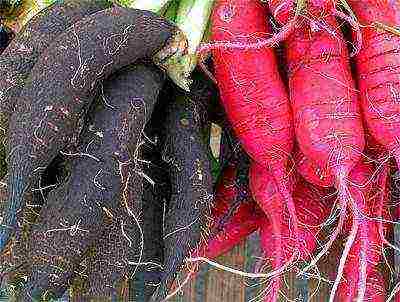 In our country, mainly European radish varieties of different ripening periods are grown, but more and more gardeners are showing interest in other types of radish: Chinese radish (lobo) and Japanese radish (daikon).
In our country, mainly European radish varieties of different ripening periods are grown, but more and more gardeners are showing interest in other types of radish: Chinese radish (lobo) and Japanese radish (daikon).
Radish varieties are divided into summer ones - they are used only fresh and winter ones - they can be stored in a cellar or basement and used in winter. Below are the most popular radish varieties among gardeners.
European radish varieties
Odessa 5... Early ripening (30-45 days from germination) variety. Root vegetable weighing 50-100 gr., With juicy white pulp. The variety is intended for summer consumption.
Sudarushka... Early maturing (about 40 days) variety. Root vegetable weighing 50-60 gr., Excellent taste. Designed for summer consumption.
Winter round black... Mid-season (70-95 days) variety. Root crop of black color, flat-rounded shape, weighing 250-600 gr. The pulp has a spicy-sweet taste, white, juicy. suitable for winter storage.
Maiskaya. Early ripe (55-65 days) grade. Root crop of rounded flat shape, weighing 80-130 gr., White pulp. Cultivation is possible throughout the season.
Winter round white... Mid-season (75-95 days) variety. A root crop of a round-oval or round-flat shape, white with a green tint, weighing 200-400 gr. The pulp is white, juicy, with a medium-spicy taste. Suitable for storage.
Munich beer... Early ripe variety. Root vegetable weighing 300-500 gr., Cylindrical, white, slightly spicy taste. For fresh use and storage in winter (until March).
Chernavka... Late ripening (105-110 days) variety. A root crop of a rounded flat shape, weighing up to 250 grams, black. The pulp is white, juicy. Suitable for winter storage.
Black woman... Late ripening (90-95 days) variety. The root crop is round-oval, black, weighing 250-300 gr. The pulp is white, juicy, with a slightly spicy taste.
Delicacy... Early maturing (about 40 days) variety. Root vegetable weighing 120-150 gr., Oval, white. The pulp is white, juicy, fresh. For summer consumption.
Grayvoronskaya... Old Russian late-ripening (93-108 days) variety. Root crop of cylindrical-conical shape, white, weighing 400-600 gr. The pulp is juicy, white, with a spicy taste. Differs in excellent keeping quality.
Japanese radish varieties (daikon)
Sasha... Early ripe (35-40 days) variety.Root vegetable weighing up to 400 gr., Short-cylindrical shape, white. The pulp is juicy, tender. The variety is resistant to mucous bacteriosis and premature steming.
The Dragon... Mid-season (60-70 days) variety. Root crop weighing 900-960 g., Cylindrical with a conical escape, smooth, 30-60 cm long, white. Recommended for fresh consumption and long-term storage.
Dubinushka... Mid-season (55-60 days) variety. Root crop weighing 1.2 kg., White, cylindrical. The pulp is white, firm, of excellent taste.
Japanese white long... Late-ripening variety. Root crop 50-65 cm long, weighing 2-3 kg. The pulp is juicy, slightly spicy taste. The variety is resistant to arrowing and flabbiness. Stores well.
Chinese radish (forehead)
Nice... Early ripe (40-45 days) grade. The root crop is long, conical in shape, weighing 120-150 grams. The pulp is juicy, tender. for summer consumption.
Hostess... Mid-season (65 days) variety. The root crop is short-cylindrical, weighing up to 150 grams, light green in color. The pulp is white, juicy.
Glow... Early ripe (50-55 days) grade. A cylindrical root crop, pink-red in color, weighing 150-300 gr. The pulp is juicy, white, tender, of excellent taste.
Severyanka... Early (58-63 days) grade. Root crop of raspberry-pink color, rounded or rounded-elongated shape, weighing 500-700 gr. The pulp is white, juicy, sweet-spicy taste. Suitable for storage.
Vegetable garden (vegetables)
|
2016-06-22 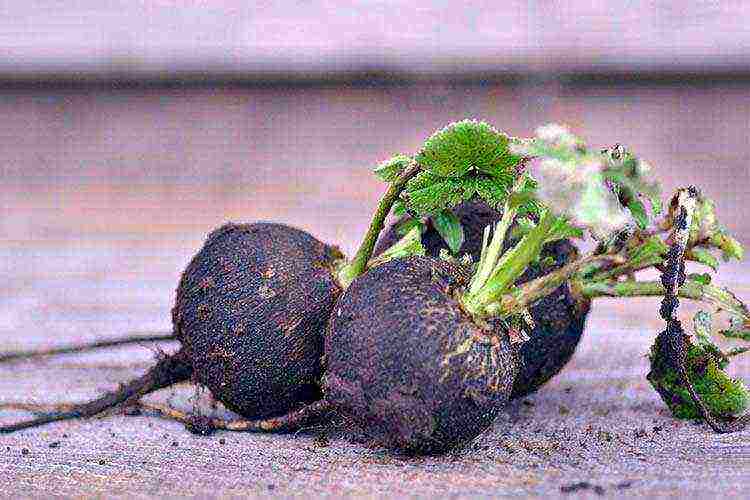 Black radish (Raphanus sativus).
Black radish (Raphanus sativus).
The end of June is a good time to plant a radish for winter storage. It is the summer radish that gives root crops, tasty and mature, suitable for long-term storage in cellars and basements until spring.
Radish is an unpretentious plant, growing well even on heavy soils, but the best yields of radish are obtained precisely on fertile and loose soils.
Light loam and sandy loam with a neutral soil solution are the best soils for growing radish. The main thing is that there is no stagnation of moisture - the radish does not tolerate it. The depth of the arable layer must be at least 25 cm, that is, one shovel bayonet.
The best precursor plants for radishes are: cucumbers, carrots, beets, potatoes, tomatoes, all types of legumes, pumpkin, squash, onions and green crops. In general, radish is compatible with cucumbers and potatoes, onions and tomatoes.
You should not grow radish in one place for several years in a row, and also plant it after the plants of the Cruciferous family: radish, cabbage, etc.
It is best to plant the radish between radishes and turnips.
They begin to prepare the soil for the radish in the fall. After harvesting the previous crops, two to three kilograms of humus (compost) are applied per 1 m2 of garden area, a teaspoon of urea and a tablespoon of superphosphate and potassium sulfate.
You cannot add fresh manure - it worsens the taste of the radish, and the pulp darkens. Better to season the soil with half a glass of wood ash.
Radish varieties for winter storage and consumption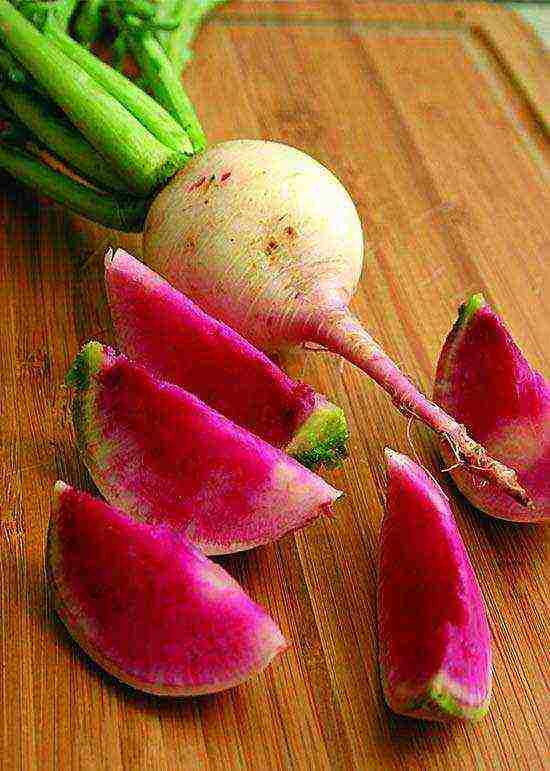 Watermelon radish
Watermelon radish
Among the many varieties of radish, we can recommend several of the most popular varieties for winter storage.
- Grayvoronskaya - an old late-ripening variety, requires loose soil, with a deep arable layer. Root crops are long, gray, with a greenish head, weighing up to 500 g. The flesh is white, juicy, firm. The taste is sharper than that of other radish varieties. Stores well in winter.
- Winter round white - mid-season variety. Root crops are flat-rounded, white, with a light green head, weighing up to 300 g or more, are well stored in winter. The pulp is white, juicy, medium-sharp.
- Winter round black - the most common mid-season fruitful variety. Root crops are flat-rounded, with black skin, weighing 250-500 g and more, are well stored in winter. The pulp is white, juicy, with a spicy rare taste.
- Levin - a new mid-season variety. Root crops are black, smooth, weighing up to 500 g. The pulp is white, juicy, sweet-spicy. Stores well in winter.
- Munich beer - mid-season, very productive variety.White roots, weighing 250–400 g, are completely submerged in the soil. They are distinguished by their spicy-sweet pulp, which adds piquancy to fresh salads. Stores well in winter.
- Black woman - late-ripening radish variety. Root crops are round, slightly oblong, weighing up to 300 g, with a black peel. The pulp is white, juicy, with a pleasant taste. Stores well in winter.
- Squirting white - mid-season variety. Root crops are flat-rounded, weighing up to 400 g. The flesh is white, dense, juicy, with a semi-sharp taste. Keeping quality is very good.
- Squirting black - mid-season variety. Root crops weigh up to 300 g. They protrude above the soil and are easily pulled out. The pulp is dense, white, juicy, of excellent taste. Keeping quality of root crops is good.
- Chernavka - a new late-ripening variety, 105–110 days pass from germination to technical ripeness. Root crops are round, black, weighing up to 300 g, less than half immersed in the soil. The pulp is white, juicy, good taste. Keeping quality is good.
Agricultural technology for growing radish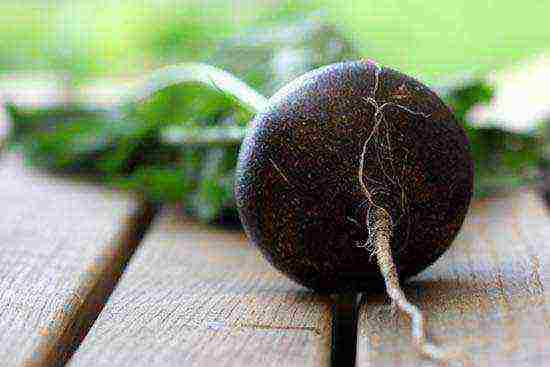 Black radish. Photo: Mojca Janželj Tomažič
Black radish. Photo: Mojca Janželj Tomažič
As mentioned above, for growing radish intended for long-term storage, seeds are sown at the end of June. Early sowing of winter radish produces many flowering plants.
When the daylight hours are long, the seeds sprout quickly, but instead of developing root crops, the plants develop a peduncle. Late sowing, for example at the end of July, does not guarantee the ripening of root crops before the onset of cold weather.
The secret to growing large radish consists in providing each plant with a large area of nutrition. In common parlance, plant the radish at large intervals between neighboring plants. If the distance is sufficient, then the roots are beautiful, of the correct rounded shape.
Winter radish varieties are distinguished by a large rosette of leaves, so a distance of 30 cm between adjacent plants is recommended. But a better harvest of radish when sowing seeds in 2 rows with a distance of 40 cm between them.
Sowing depth radish seeds for summer sowing - 3 cm... They are often placed in nests of 2-3 pieces with a distance of 15 cm between the nests. The seeds can be dry or germinated.
Before sowing, it is advisable to water the grooves from a watering can without a sieve, and after sowing, the rows are rolled with a roller or tamped by hand - this event guarantees the appearance of friendly shoots.
It is recommended to mulch crops of radish with humus or peat. If a soil crust forms on the bed, then it is loosened, trying not to damage the seedlings.
Radish seedlings appear in 7-8 days, and when sown in warm and moist soil with germinated seeds - after 3-5 days.
While the radish seedlings are small, it is necessary to protect the plants from the cruciferous flea. The flea severely damages young plants, eating up significant parts of the plants, after which they dry out.
To scare away pests from radish shoots, dusting is carried out with tobacco dust mixed with ash or lime in equal proportions or wood ash. Dust strictly after the dew dries.
Dense crops are not for radish. From the first days of emergence, the distance between neighboring plants should be more than 2 cm - young seedlings react poorly to thickening.
August, winter radish after the second thinning. Photo: vkusniogorod.
The radish is thinned out in the phase of 2-3 true leaves, leaving strong plants. At the beginning, they are thinned out every 5–6 cm, and then after 10–12 cm or more for large-fruited late varieties.
It is imperative to thin out - thickened plantings of radish are shooted and instead of root crops they form flowering stems.
When thinning the radish again, weak and damaged seedlings are removed. Too much distance between plants gives large roots, to the detriment of taste.
Radish care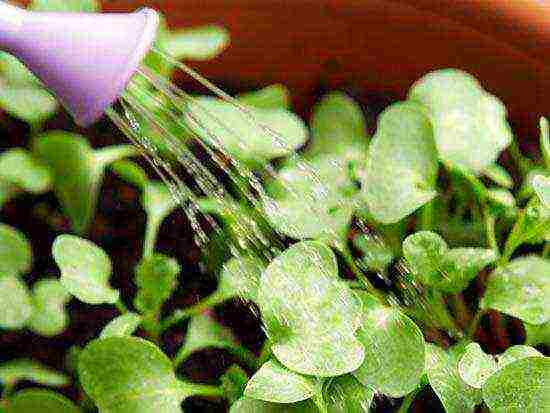 Radish seedlings are watered with warm water.
Radish seedlings are watered with warm water.
Radish care is loosening the soil and regular watering with warm water
In the first days after planting, it is undesirable to water the crops so that the radish takes root well and takes root.On the following days, they provide optimum soil moisture, especially in the first period of growth.
Mature radish plants absorb moisture from the lower layers of the soil and require watering only during prolonged drought. In this case, it is watered in several steps so that the soil is saturated with water to the entire depth of the roots.
Violation of the moisture regime results in radish root crops with internal voids, the radish becomes corky.
Radish doesn't like soil crust, therefore, after rain or watering, the soil in the garden bed must be loosened, especially on heavy clay soils.
Fertilizing radish
On poor soils and with weak plant growth, make one top dressing with nitrophos (1 tablespoon per 10 liters of water) in the first phase of radish growth. During the second and third feeding, only phosphorus and potash fertilizers should be applied.
Do not overdo it with the introduction of nitrogen fertilizers - they cause rapid growth of the tops to the detriment of the crop. If there is no mineral fertilizers, the plants are fed with ash.
3 weeks before harvesting the radish, watering and feeding are stopped.
So that the radish is of the correct shape, it is slightly swayed. In this case, the upper side roots come off. After the radish is spud, and the pulp of the root vegetables turns out to be more tender.
Harvesting and storage of crops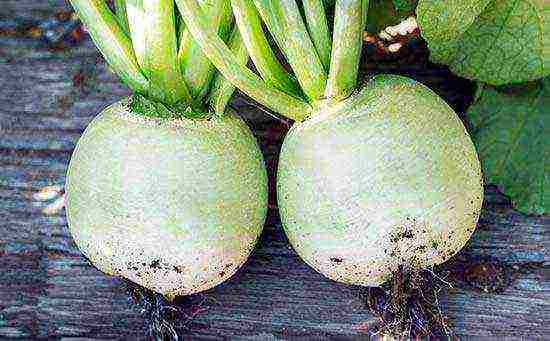 The radish harvest in the fall is carefully sorted. Photo: GREG HADEL
The radish harvest in the fall is carefully sorted. Photo: GREG HADEL
The timing of harvesting winter radish depends on the condition of the root crops and weather conditions. If the weather is dry, then you need to postpone the harvesting - early harvested root crops are poorly stored in winter.
Late varieties of radish are harvested 7–8 days before the onset of frost, since frozen roots are poorly stored.
The crop is harvested in dry weather, then the roots will be clean and not saturated with moisture.
Dig up the radish without damage. Damage to the peel drains the roots and reduces their quality, impairs storage. The leaves are cut at a height of 1.5-2 cm from the root crop.
Only healthy root crops are placed for winter storage, previously powdered with ash or chalk. Dusting protects the radish from rot: bacteriosis and phomosis.
The optimum storage temperature for radish in winter is + 1–2 ° C.
